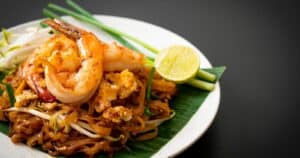Thai food is delicious. The bright, tangy flavors. The fresh herbs and spices. It’s no wonder Thai is one of the most popular ethnic cuisines. But if you’ve ever dug into a plate of spicy pad thai or green curry only to get hit with a raging headache later, you know Thai food’s not always an easy date.
So what gives? Can Thai food really cause headaches? And if so, how can you still enjoy the cuisine you love without ending the night in pain? This article has the answers.
What’s Behind the Thai Food Headache Connection?
First things first: Can Thai food actually trigger headaches?
The short answer is yes. Certain ingredients commonly used in Thai cooking are known to cause headaches in some people. But it’s not as simple as blaming that extra-spicy green curry or peanut sauce. (Pro Tip: While spiciness can exacerbate headaches, it’s usually not the root cause.)
To get to the bottom of the Thai food-headache mystery, you need to understand two things:
- Common headache triggers found in Thai dishes
- Why these triggers affect some people more than others
Understanding both will help you pinpoint whether Thai food could be causing your headaches. And if so, how to still enjoy it without pain.
3 Thai Ingredients That Can Trigger Headaches
Here are three commonly used ingredients in Thai cooking that contain compounds capable of causing headaches in sensitive individuals:
1. Soy Sauce
Many Thai dishes like noodle and rice dishes contain soy sauce. In fact, soy sauce is considered essential for delivering that signature Thai flavor.
The problem is soy sauce contains tyramine. This natural compound has been linked to headaches and migraines in those who are sensitive.
Tyramine is also found in some alcoholic beverages, cured meats, and fermented foods. So for tyramine-sensitive folks, piling on soy sauce can easily trigger headaches.
2. Fish Sauce
Like soy sauce, fish sauce adds that quintessential savory, salty flavor to many Thai dishes. It contains high levels of tyramine, as well as histamine, so it poses a double threat for potential headaches.
People with histamine intolerance can develop headaches or migraine symptoms from histamine-rich foods like fish sauce.
3. Coconut Milk
Coconut milk is another staple ingredient in Thai curries, sauces, and desserts that can be problematic for some. That’s because coconut contains tyramine and other biogenic amines capable of provoking headaches in sensitive individuals.
Why Do These Compounds Trigger Headaches?
Tyramine, histamine, and other biogenic amines are organic nitrogenous compounds that can dilate blood vessels in the brain. This triggers reactions like headaches in those who don’t metabolize them efficiently.
Your susceptibility really boils down to genetics and individual tolerance levels. Some folks are simply wired in a way that makes them more reactive to tyramine and histamine.
Age may also play a role, as your ability to metabolize amines may decrease as you get older.
The bottom line? If you notice a pattern of headaches hitting after eating Thai food, tyramine or histamine sensitivity could be the culprit. Time to do some detective work.
Signs Thai Food May Be Triggering Your Headaches
Wondering if Thai food is behind your headaches? Look for these clues:
- Headaches often strike within hours of eating Thai dishes containing soy sauce, fish sauce, or coconut milk.
- You experience other symptoms along with the headache like flushing, nausea, or irritability.
- The headaches have a rapid onset and pulsating quality, similar to migraine symptoms.
- OTC meds provide little relief, or the headache returns shortly after taking them.
- Eliminating suspected trigger ingredients like soy/fish sauce and coconut provides relief. Headaches improve or resolve when you avoid these foods.
If this sounds familiar, don’t resign yourself to a life without Thai food just yet. There are still plenty of ways to enjoy it without pain.
But first, let’s explore other common culprits behind Thai food headaches.
Beyond Amines: Other Potential Causes
While tyramine and histamine intolerance are common culprits, other factors could also be playing a role in your Thai food headaches:
High Sodium
Like many Asian cuisines, Thai cooking relies heavily on sauces and condiments high in sodium. Think soy sauce, fish sauce, oyster sauce, and shrimp paste.
Consuming large amounts of sodium may cause headaches in salt-sensitive individuals by:
- Increasing blood pressure
- Triggering dehydration
- Promoting fluid retention
To minimize sodium-related headaches, opt for dishes with lighter sauces and balance out salty dishes with electrolyte-rich fluids.
MSG
This flavor enhancer is used liberally in Thai food. But for a small subset of folks, monosodium glutamate (MSG) can trigger headaches.
However,MSG headaches are poorly understood and highly individualized. Many people demonize MSG for headaches despite tolerating it perfectly well!
Regardless, MSG is easy to avoid if you suspect sensitivity. Opt for dishes without that added oomph of flavor.
Additives and Preservatives
Certain food additives like nitrates, sulfites, and artificial sweeteners are infrequent, but potential headache triggers. Asking about these added ingredients never hurts.
Food Intolerances
Gluten, lactose, or compounds in nightshade vegetables provoke headaches in some people. Since Thai food often includes dairy, wheat-based sauces, and nightshades, intolerances may be at play.
Alcohol (or Lack Thereof)
Drinking alcohol with meals rapidly boosts tyramine absorption. But oddly enough, abruptly stopping alcohol consumption can also cause headaches in regular drinkers due to neural rebound effects.
Either way, managing your alcohol intake and being consistent is key if Thai food already makes you headache prone.
Individual Sensitivities
In rare cases, ingredients like chilies, citrus fruits, or spices directly irritate nerves involved in headache development. Figuring out unique food triggers takes trial and error.
Tips for Dodging Thai Food Headaches
By now it’s clear that Thai food headaches stem from complex, individualized causes. While you shouldn’t necessarily avoid it, you can take steps to prevent those post-meal headaches from striking.
1. Track Your Triggers
Pinpointing exactly which ingredients, dishes, and restaurant styles correlate with your headaches delivers powerful insight. Take note of:
- Specific ingredients that seem to trigger headaches (e.g. soy sauce, coconut milk)
- Certain dishes or menu items that precede headaches
- Differences among Thai restaurants, if headaches occur at some more than others
With diligent tracking, you can discover patterns and adopt a personalized avoidance approach. Don’t forget to log beverages too!
2. Adjust Your Order
Rather than avoiding Thai cuisine altogether, make strategic tweaks and substitutions:
- Request dishes cooked without problem sauces or ask for them on the side.
- Opt for protein and vegetable-centric dishes like grilled meat skewers with light dipping sauces.
- Choose tom yum soup over curries if coconut milk is a problem.
- Ask for brown rice or rice noodles instead of wheat-based noodles.
- Limit high-sodium condiments like fish sauce and shrimp paste.
- Spice it yourself by adding chili sauce or sambal as needed.
3. Control Portions
Consuming smaller yet more frequent meals is an easy way to minimize exposure to potential triggers. Share family-style dishes so you taste everything without going overboard.
Boxing half right away further helps cap intake of sodium, fat, amines, spices or other headache instigators.
4. Hydrate Proactively
Head off headaches triggered by dehydration, alcohol, or sodium by drinking plenty of water before, during, and after meals.
Coconut water, electrolyte drinks, and decaffeinated tea also help replenish fluids and minerals.
5. Time it Right
Eat early if late meals lead to restless sleep and morning headaches. On the flip side, having a substantial snack beforehand can prevent blood sugar crashes.
Learn your optimal timing and meal patterns to thwart headaches. An empty stomach may not always be best!
6. Ask About Ingredients
Don’t be shy! Politely ask about preparation methods, ingredients, sauce bases, and potential food allergens on the menu.
Most Thai restaurants are happy to accommodate restrictions and modify orders. Better safe than sorry.
7. Try a Headache-Busting Recipe
Whip up modified Thai recipes at home using clean ingredients, lighter sauces, and controlled sodium levels.
Check out cookbooks and blogs focusing on headache-friendly versions of Thai classics. Cooking at home rocks!
When to Seek Help
Most Thai food headaches are preventable with a little strategizing. But if headaches persist despite your best efforts, see your doctor.
Keep a detailed food/symptom journal and request testing for food sensitivities. For frequent migraines, prescription preventatives or triptan medications could be needed.
Likewise, get evaluated if you experience worrisome headache symptoms like:
- Sudden and severe onset
- Fever or stiff neck
- Confusion, seizure, vision loss, or weakness
- Headaches awakening you from sleep
Diagnostic testing can pinpoint if an underlying condition, infection, or headache disorder is at play.
The bottom line? You don’t have to say goodbye to your favorite Thai dishes. With awareness and a few adjustments, you can





